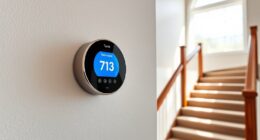To optimize your smart thermostat for winter, set your daytime temperature around 68°F (20°C) for comfort and energy efficiency, and lower it to 60-65°F (15-18°C) during sleep or away periods. Use features like scheduling, geofencing, and remote control to adjust settings automatically based on your routine and location. Regularly review your energy use to find additional savings. Keep exploring to discover more tips for maximizing your heating system’s efficiency during winter.
Key Takeaways
- Set daytime temperatures around 68°F (20°C) and lower to 60-65°F (15-18°C) during sleep or absences for efficiency.
- Use smart scheduling to gradually warm the home before waking and reduce heating during low activity periods.
- Enable geofencing to automatically adjust temperature based on your proximity, ensuring comfort upon arrival.
- Regularly review energy reports to identify patterns and optimize thermostat settings for savings.
- Leverage smart features like learning algorithms to automatically adapt settings for winter comfort and efficiency.

As the seasons change, adjusting your smart thermostat settings can help you stay comfortable while saving energy. When winter arrives, setting your thermostat appropriately is key to balancing warmth and efficiency. You want to guarantee your home stays cozy without wasting energy, and smart thermostats make this easier by allowing precise control. By fine-tuning your settings for winter, you can optimize energy savings while maintaining user comfort, preventing unnecessary heating that drives up costs and wastes resources.
Start by lowering your daytime temperature to around 68°F (20°C) when you’re home and active. This temperature is generally comfortable for most people and helps save energy compared to higher settings. When you’re asleep or away, consider setting your thermostat lower—around 60-65°F (15-18°C)—to reduce heating without sacrificing comfort upon your return. Many smart thermostats have scheduling features that let you automate these adjustments, ensuring your home isn’t heated unnecessarily during periods of low activity. This not only cuts energy consumption but also prolongs the lifespan of your heating system.
Leverage your smart thermostat’s learning capabilities if it has them. These features analyze your routines and automatically adjust settings to match your preferences, enhancing user comfort without requiring constant manual input. For instance, if you typically wake up at 6:30 am, your thermostat can gradually warm the house beforehand, avoiding cold mornings. During the day, if you’re away at work or errands, your system can lower the temperature, then warm up again before you return. This dynamic adjustment maximizes energy savings while keeping the environment comfortable when you’re home.
Utilize features like remote control and geofencing to optimize your heating. With remote access, you can make adjustments from your phone if plans change unexpectedly. Geofencing detects when you’re approaching home and can automatically adjust the temperature to your preferred comfort level, ensuring you never walk into a cold house. These smart features help fine-tune your system’s operation, balancing energy efficiency with user comfort seamlessly.
Finally, don’t forget to regularly review your thermostat’s settings and energy reports. Monitoring your energy usage helps identify patterns and opportunities for further savings. Additionally, being aware of grocery savings strategies can contribute to overall household budgeting and resource management. Small adjustments, like slightly lowering the temperature at night or during extended absences, can add up notably over time. By actively managing your winter thermostat settings, you create a more energy-efficient home that remains comfortably warm, reducing costs and environmental impact while keeping everyone cozy throughout the chilly months.
Frequently Asked Questions
Can Smart Thermostats Learn My Preferred Winter Temperatures Automatically?
Yes, smart thermostats can learn your preferred winter temperatures automatically. Using advanced learning algorithms, they analyze your habits and adjust settings for temperature optimization. Over time, they adapt to your schedule, ensuring comfort while saving energy. You don’t need to manually change the temperature constantly; the thermostat predicts your needs and makes adjustments, providing a seamless and efficient heating experience that aligns with your lifestyle.
How Do I Update or Change My Seasonal Thermostat Settings Easily?
Imagine you want warmer mornings; you can update your thermostat by manually adjusting the temperature or setting new scheduling preferences. To do this easily, access your smart thermostat’s app or control panel, navigate to the settings, and choose the option to change your seasonal settings. You can adjust temperatures for specific times or days, ensuring your home stays cozy without wasting energy. It’s simple and customizable to fit your winter routine.
Are There Energy-Saving Tips Specific to Smart Thermostats During Winter?
To save energy with your smart thermostat during winter, use programming tips like setting your thermostat to lower temperatures when you’re away or asleep. Take advantage of user customization features to create personalized schedules that optimize comfort and efficiency. Regularly review and adjust these settings based on your routine, and consider using occupancy sensors or geofencing to automatically adjust temperatures, ensuring you’re never wasting energy when you’re not home.
Can I Control My Smart Thermostat Remotely When Away From Home?
You can absolutely control your smart thermostat remotely—it’s as easy as a tap on your phone! With remote access and mobile control, you can adjust your home’s temperature from anywhere, even if you’re halfway across the world. No need to worry about wasting energy or coming home to a chilly house. Just open the app, set your preferred temperature, and enjoy the comfort of knowing you’re in full control, anytime, anywhere.
What Safety Features Do Smart Thermostats Offer for Winter Heating?
Smart thermostats offer safety features like safety sensors to detect unusual temperature changes, preventing overheating or fires. They also include frost protection, which automatically maintains a minimum temperature to prevent pipes from freezing. These features keep your home safe during winter, giving you peace of mind whether you’re home or away. By monitoring your heating system, smart thermostats help avoid costly damages and ensure a secure, warm environment all season long.
Conclusion
Just like Frost’s warm embrace or a cozy hearth on a cold night, your smart thermostat can keep your winter comfort both cozy and efficient. By adjusting settings seasonally, you’re channeling the wisdom of those who know how to balance warmth and savings. Remember, a little planning now can transform your home into a haven—because, in the end, even Scrooge would agree, it’s the warmth of smart choices that truly warms the soul.








